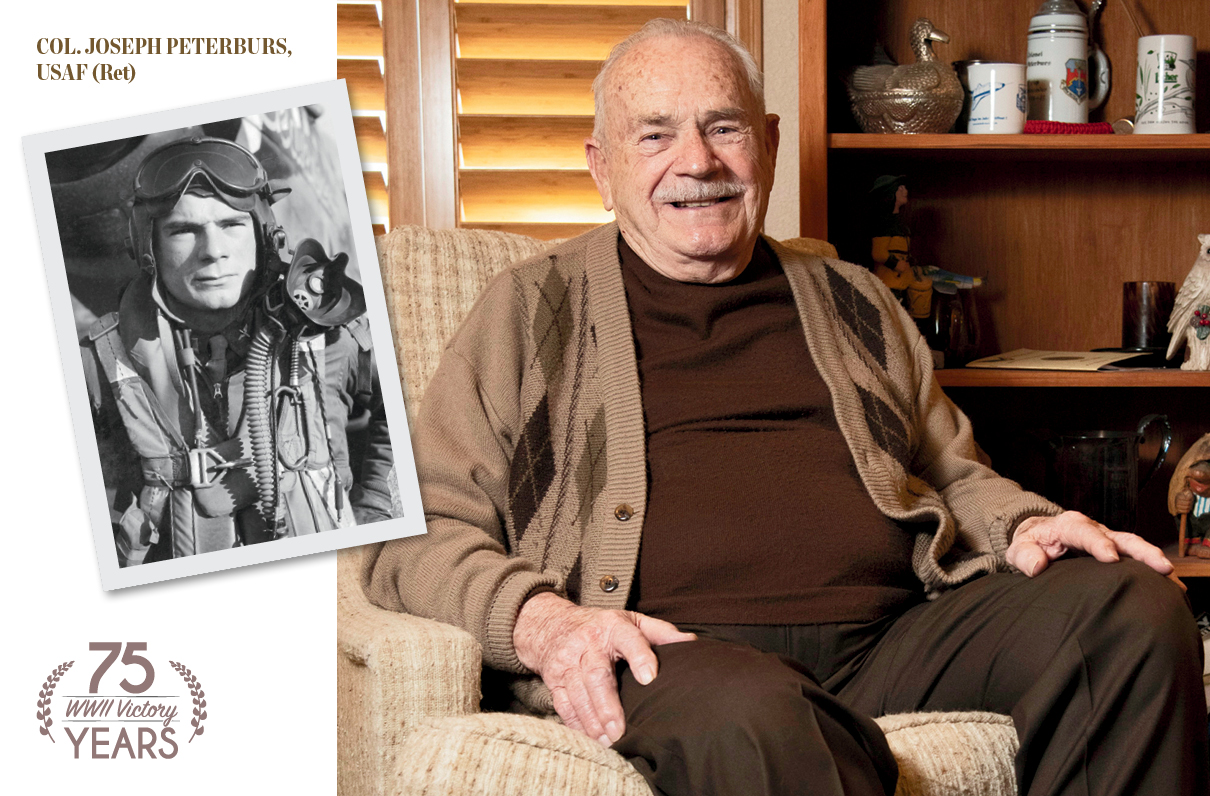(This article and others in MOAA’s “Window Into War” series originally appeared in the May edition of Military Officer, a magazine available to all MOAA Premium and Life members. Learn more about the magazine here; learn more about joining MOAA here.)
Joseph Peterburs flew his P-51 Mustang close to the B-17 bombers he was escorting through the sky above Berlin, just as he had on 48 previous missions during WWII.
But on his 49th mission, the Germans flooded the sky with fighters. Peterburs, an adrenaline-filled 19-year-old, soared through the sky chasing a German fighter he saw blow up a B-17 bomber. He closed in as it hit a second bomber.
“Just as he blew up the second, I came in from the rear,” Peterburs said. “I saw smoke and fire on his left wing. He immediately rolled over and started to the deck. I just broke off the chase.”
If the attack on Pearl Harbor hadn’t happened four years prior, Peterburs would have been back in Wisconsin studying to be a priest. But now he was in German airspace — and spotted an airfield full of the enemy’s aircraft.
“I was by myself, 19 years old,” said Peterburs. “I made too many passes, and I destroyed at least five on the ground and set a hangar on fire.”
Trouble Afoot
On his last pass, Peterburs was hit and his engine started to overheat. He had 90 miles to reach the airbase, but his aircraft was losing altitude quickly.
He debated bailing out when the aircraft fell to 1,000 feet, but then he saw a German Focke-Wulf 190 fighter coming at him. The 190 fired off rockets but missed, and Peterburs kept flying.
[RELATED: ‘A Survivor and a Liberator’: Col. Frank Cohn, USA (Ret), on His World War II Service]
At 500 feet, Peterburs was devising a belly landing, but he kept going. At 300 feet, the right side of the aircraft caught fire. Peterburs waited too long and had to bail from the left side, which guaranteed he would hit the aircraft’s tail on his exit.
Peterburs landed in an open field with townspeople yelling and running toward him. Peterburs was sent to a POW camp for the night. He escaped with a small group.
“There was very little security,” Peterburs said. “Basically, it was just going down to the fence at night.”
After their midnight escape, the group walked for about five miles toward Berlin when they were stopped by a Russian tank unit. Through the Russian lieutenant’s English, the men learned the tank unit was headed to Wittenburg.
Peterburs said he was given a rifle and told to hop on. The Americans fought with the Russians for the next three days.
[RELATED: Stuck at Home? Visit These Military Museums and Monuments Virtually]
Peterburs finally got his break when an American patrol noticed his flight suit among the Russian tank crew camped out near the Elbe River. Peterburs was reluctantly turned over to the Americans and began his journey home.
Once he was back in the U.S., Peterburs married his girlfriend, Josephine, for whom he had nicknamed the Mustang P-51 that helped him destroy so many enemy aircraft on his 49th combat mission.
Unlikely Reunion
Peterburs left the war behind as a memory — until the late 1990s. That’s when he received a letter from a German man who was just a boy when he watched Peterburs fall into the German farmland. The man tracked down Peterburs from a piece of the downed aircraft that he saved.
In 2005, Peterburs was surprised when again he received a letter from the man — this time telling him he had found the German pilot whom he had been chasing through the sky that April day in 1945. And it wasn’t just any pilot — it was Walter Schuck, a top German pilot with 206 confirmed aerial victories.
Schuck claimed four American B-17s just before Peterburs shot him down. The men met for the second time, this time on friendlier terms, when Schuck traveled to the U.S. in 2005.
“Both of us reconciled the relationship by recognizing that we were each doing our job,” Peterburs said.
MOAA Knows Why You Serve
We understand the needs and concerns of military families – and we’re here to help you meet life’s challenges along the way. Join MOAA now and get the support you need.

